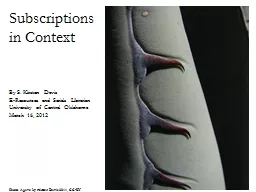PPT-David V. Stark In collaboration with: Sheila Kannappan, Kathleen Eckert, Jonathan Florez,
Author : pasty-toler | Published Date : 2018-02-09
Multi Scale Environmental Influences on Galaxy Gas Content Environmental processes can influence galaxy gas content Small dark matter halo scale Gas replenishment
Presentation Embed Code
Download Presentation
Download Presentation The PPT/PDF document "David V. Stark In collaboration with: Sh..." is the property of its rightful owner. Permission is granted to download and print the materials on this website for personal, non-commercial use only, and to display it on your personal computer provided you do not modify the materials and that you retain all copyright notices contained in the materials. By downloading content from our website, you accept the terms of this agreement.
David V. Stark In collaboration with: Sheila Kannappan, Kathleen Eckert, Jonathan Florez,: Transcript
Download Rules Of Document
"David V. Stark In collaboration with: Sheila Kannappan, Kathleen Eckert, Jonathan Florez,"The content belongs to its owner. You may download and print it for personal use, without modification, and keep all copyright notices. By downloading, you agree to these terms.
Related Documents














